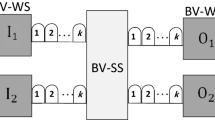Abstract
One of the key elements of modern fiber-optic systems is an optical switch. So, the next-generation all optical switching systems have been presented by authors of the paper [1, 2]. Those systems have been based on \(4\times 4\) and \(8\times 8\) switching elements and ones have high performance and low complexity. And here we offer the models and algorithms of the all-optical \(8\times 8\) and \(64\times 64\) switching systems with decentralized control for the first time. The presented models is based on the graph theory and they allow us to get so-call non-blocking conditions for the first time also. The analytical model for the complexity and diameter of the proposed schemes is presented for the first time. The characteristics of the offered systems are compared with well-known schemes too. And the calculation results showed a significant advantage of the presented systems in comparison with the well-known existing ones.
The reported study was founded by RFBR according to the research project 18-37-00059/18.
Access this chapter
Tax calculation will be finalised at checkout
Purchases are for personal use only
Similar content being viewed by others
References
Vytovtov, K.A., Barabanova, E.A., Podlazov, V.S.: Model of next-generation optical switching system. Commun. Comput. Inf. Sci. 918, 377–386 (2018)
Vytovtov, K.A., Barabanova, E.A., Barabanov, I.O.: Next-generation switching system based on \(8\times 8\) self-turning optical cell. In: Proceedings of International Conference on Actual Problems of Electron Devices Engineering, Saratov, pp. 306–310 (2018)
Golubev, A., Chechetkin, I., Parygin, D., Sokolov, A., Shcherbakov, M.: Geospatial data generation and preprocessing tools for urban computing system development. Proc. Comput. Sci. 101, 217–226 (2016). Proceedings of the 5th International Young Scientist Conference on Computational Science, Krakow, Poland. Elsevier
Vishnevskiy, V., Semenova, O.: Queueing system with alternating service rates for free space optics-radio hybrid channel. In: Vinel, A., Bellalta, B., Sacchi, C., Lyakhov, A., Telek, M., Oliver, M. (eds.) MACOM 2010. LNCS, vol. 6235, pp. 79–90. Springer, Heidelberg (2010). https://doi.org/10.1007/978-3-642-15428-7_9
Kutuzov, D., Osovsky, A., Stukach, O., Starov, D.: CPN-based model of parallel matrix switchboard. In: Moscow Workshop on Electronic and Networking Technologies (MWENT): Proceedings of National Research University “Higher School of Economics”. Russia, Moscow, 14–16 March 2018. https://ieeexplore.ieee.org/document/8337180
Bawab, E.I.: Optical Switching. Springer, Heidelberg (2006)
Kabacinski, W.: Nonblocking Electronic and Photonic Switching Fabrics. Springer, Heidelberg (2005)
Chai, Z., Hu, X., Wang, F., Niu, X., Xie, J., Gong, Q.: Ultrafast all-optical switching. In: Advanced Optical Materials, p. 21 (2017)
Podlazov, V.S.: A Comparison of system area networks: generalized extended multiring vs flattened butterfly. Autom. Remote Control 79(3), 571–580 (2018)
Karavay, M.F., Podlazov, V.S.: An extended generalized hypercube as a fault-tolerant system area network for multiprocessor systems. Autom. Remote Control 76(2), 336–352 (2015)
Lin, X., Sun, W., Veeraraghavan, M., Hu, W.: Time-shifted multilayer graph: a routing framework for bulk data transfer in optical circuit-switched networks with assistive storage. Opt. Soc. Am. 3(3), 162–174 (2016)
Author information
Authors and Affiliations
Corresponding author
Editor information
Editors and Affiliations
Rights and permissions
Copyright information
© 2019 Springer Nature Switzerland AG
About this paper
Cite this paper
Barabanova, E., Vytovtov, K., Podlazov, V. (2019). Model and Algorithm of Next Generation Optical Switching Systems Based on \(8\times 8\) Elements. In: Vishnevskiy, V., Samouylov, K., Kozyrev, D. (eds) Distributed Computer and Communication Networks. DCCN 2019. Lecture Notes in Computer Science(), vol 11965. Springer, Cham. https://doi.org/10.1007/978-3-030-36614-8_5
Download citation
DOI: https://doi.org/10.1007/978-3-030-36614-8_5
Published:
Publisher Name: Springer, Cham
Print ISBN: 978-3-030-36613-1
Online ISBN: 978-3-030-36614-8
eBook Packages: Computer ScienceComputer Science (R0)




